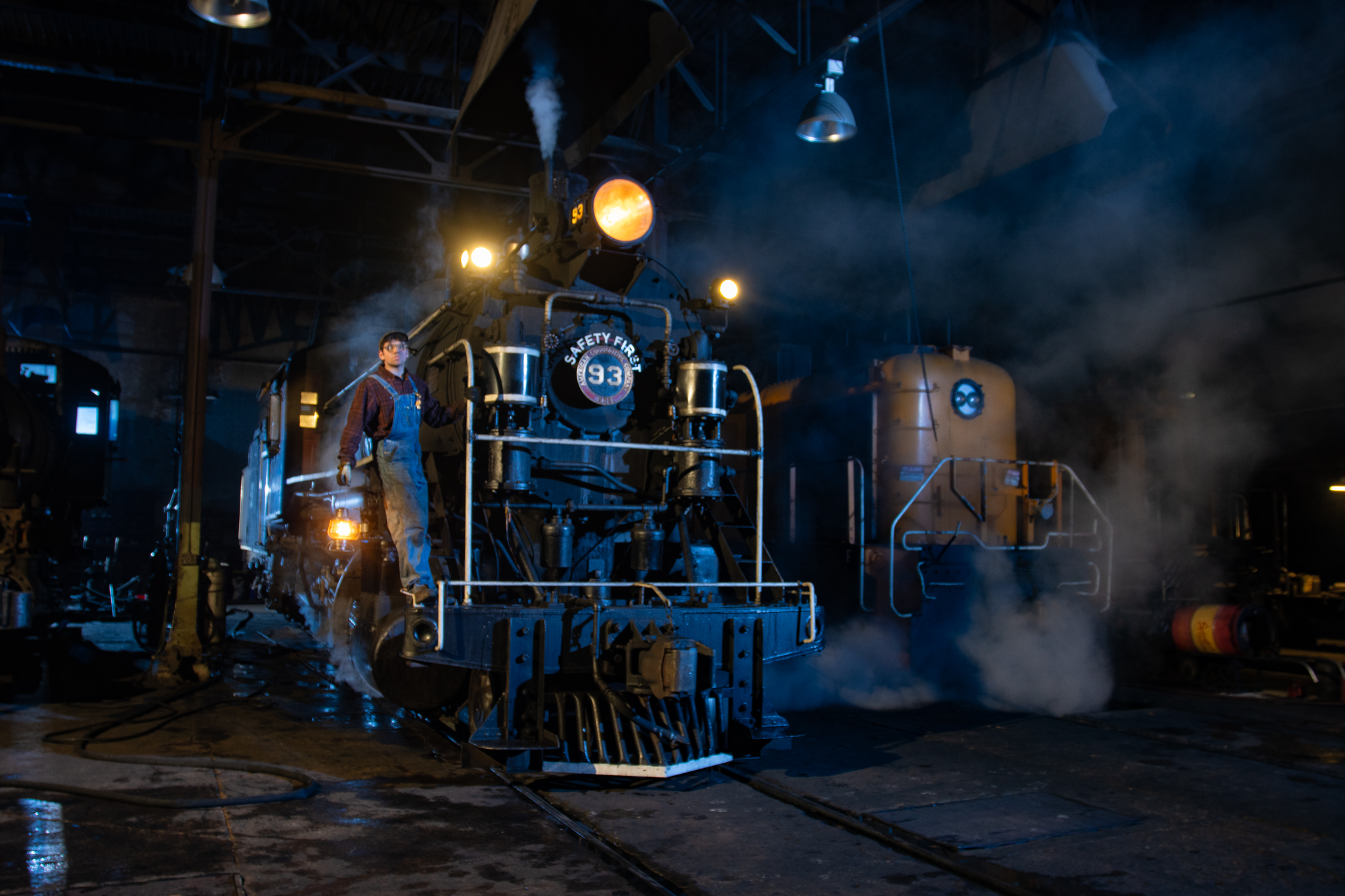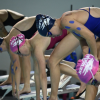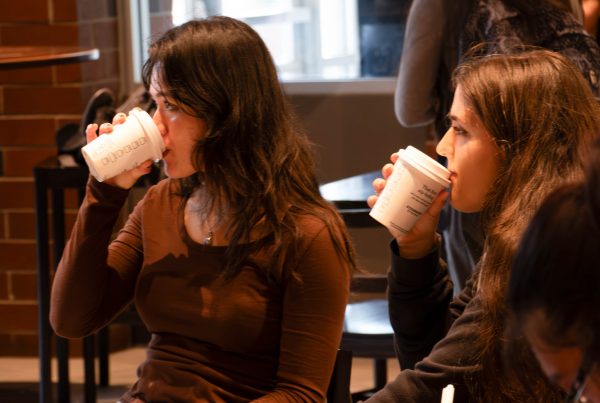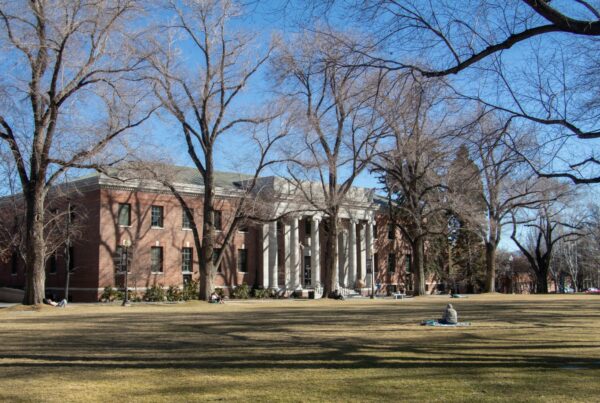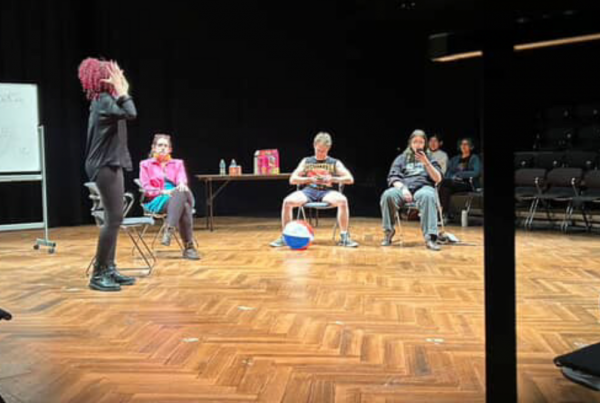
I visited the historic Nevada Northern Railway Museum in Ely, Nevada last weekend to participate in a weekend-long, winter themed photoshoot that the museum hosts during two weekends in February.
This was my second time attending this event and I had won both of my trips to these photoshoots through a scholarship contest called the Steam, Steel and Strobes Scholarship, where young photographers submit three of their best photos along with a short essay that explains your background and your three submissions. The prize for the contest also includes a monetary prize of either $500 or $750.
The Nevada Northern Railway Museum was established in 1984 after the rails and facilities from the Nevada Northern Railway were given to the City of Ely from the Kennecott Copper Corporation, who operated the railway until 1983.
Since then, the museum has restored and operated a fleet of both historic steam and diesel locomotives and offers train rides and tours to visitors.
The railroad traditionally runs their steam engines from Spring to Fall, so these winter photoshoots offer photographers a rare opportunity to see steam locomotives running in cold weather.
Trains are something that I’ve always found to be fascinating. When I got into photography, they immediately became my main subject, which worked out because they are pretty neat subjects. A lot of people thought it was really strange and so I didn’t like to talk about it with anyone. But during my time at the Reynolds School of Journalism, I discovered that they worked really well for some projects I had in different classes. When we would share our projects in class, my peers became really interested in my work since it’s kind of an unusual subject. Nowadays, I really enjoy tying railroading into a lot of the stories I do, such as this one.
Instead of taking my usual newsy approach to this story, I thought a personal narrative about my trip along with a walkthrough of each photo would work better.
Day 1
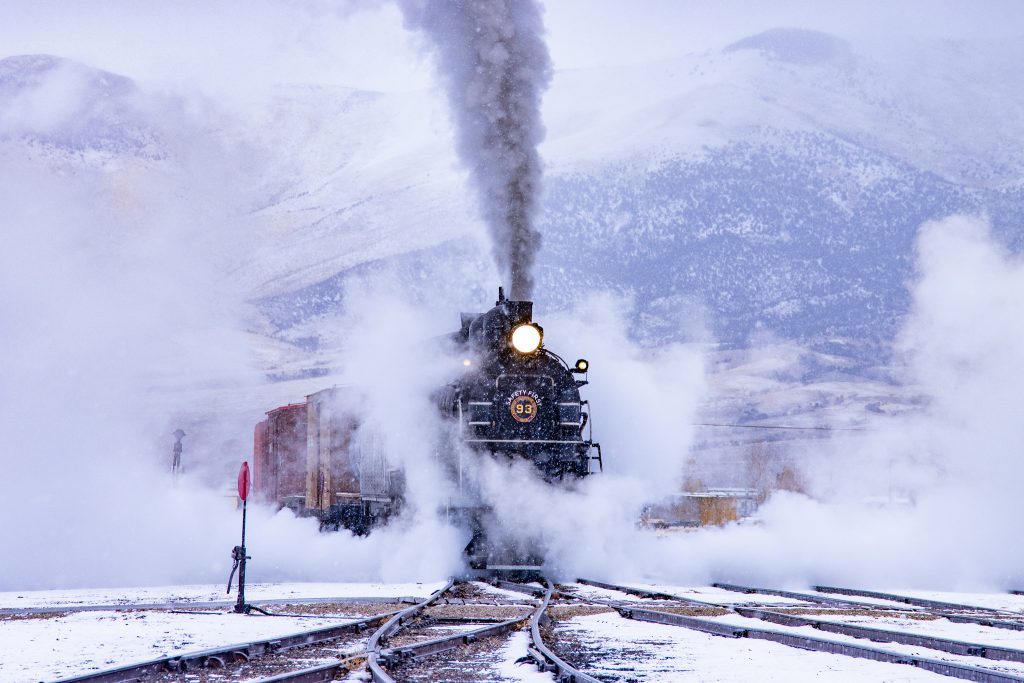
After encountering whiteout conditions about an hour outside of my destination, I finally emerged into clearer weather in Ely. The photoshoot was scheduled to start at 1 p.m. that afternoon, and the poor weather conditions had only left me with a few minutes to spare by the time I got to the museum.
Once the other photographers and I went outside to begin the photoshoot, that snowstorm I encountered earlier had arrived in Ely. While the snow added a level of danger to my journey, I was able to get some great photos that afternoon.
The engine depicted here is Locomotive 93. Built in 1909, it was designed to haul trains loaded with copper ore that came from the mines nearby. Locomotive 93 was retired in 1961 after the railroad modernized their fleet by purchasing new diesel locomotives. Avoiding the scrap yard, 93 was donated to the White Pine Public Museum that same year and remained there until 1990 when it was returned to the railroad’s shops and restored three years later in 1993. The 93 is considered to be the big engine out of the three steam locomotives the museum operates.
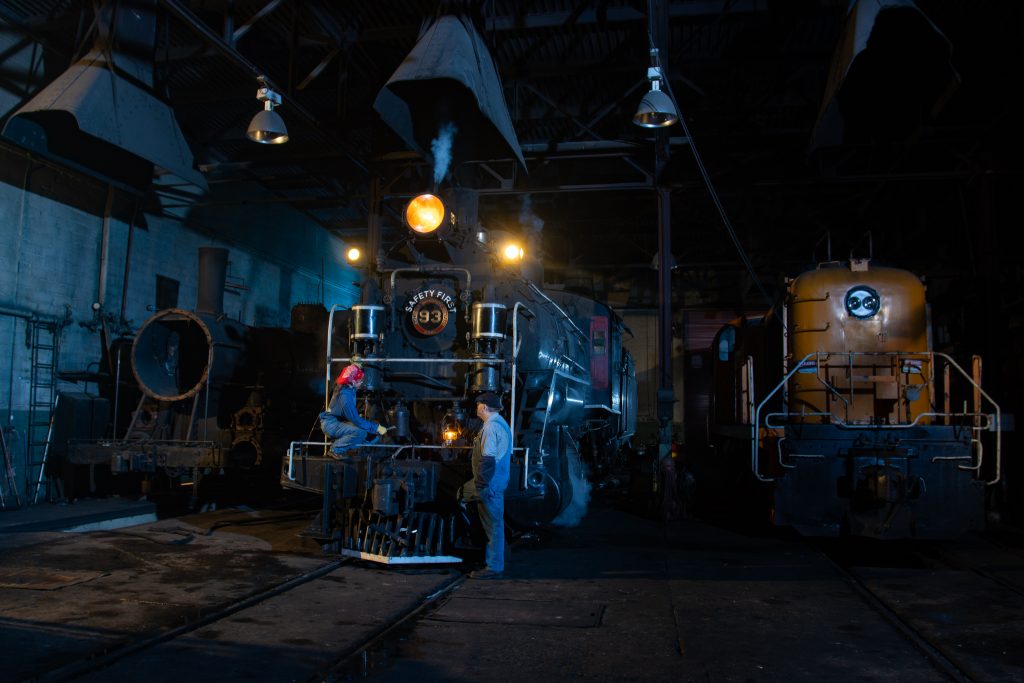
Due to the inclement weather, the night photo session for this past weekend’s event was organized in the railroad engine house. The night photo session has been a tradition during the Winter Steam Photoshoot for years.
The organizers try to switch up the location of the night session every year, and the weather can play a role in determining where it happens. The engine house in this photo was built in 1917 and still serves the railroad, protecting equipment from the elements and providing a space to maintain it.
This night session that we held in the engine house made for some pretty fabulous images that you’d maybe see in a magazine feature. We all gathered here a little after sunset and we had a strobe light set up with a blue gel that would give the images a blue hue but in a way that captures the mood of a nighttime moment on the railroad. I set my camera up on a tripod, set my ISO to 200, my aperture to f/6.3 and let my shutter speed roll for about two seconds.
For a few photos, we also had a couple of the railroad employees model for us to add a human element to the scene. The quick flash of the strobe combined with the golden glow of the 93’s headlight and the escaping steam gave a cinematic quality to my photos that I haven’t seen before in my work.
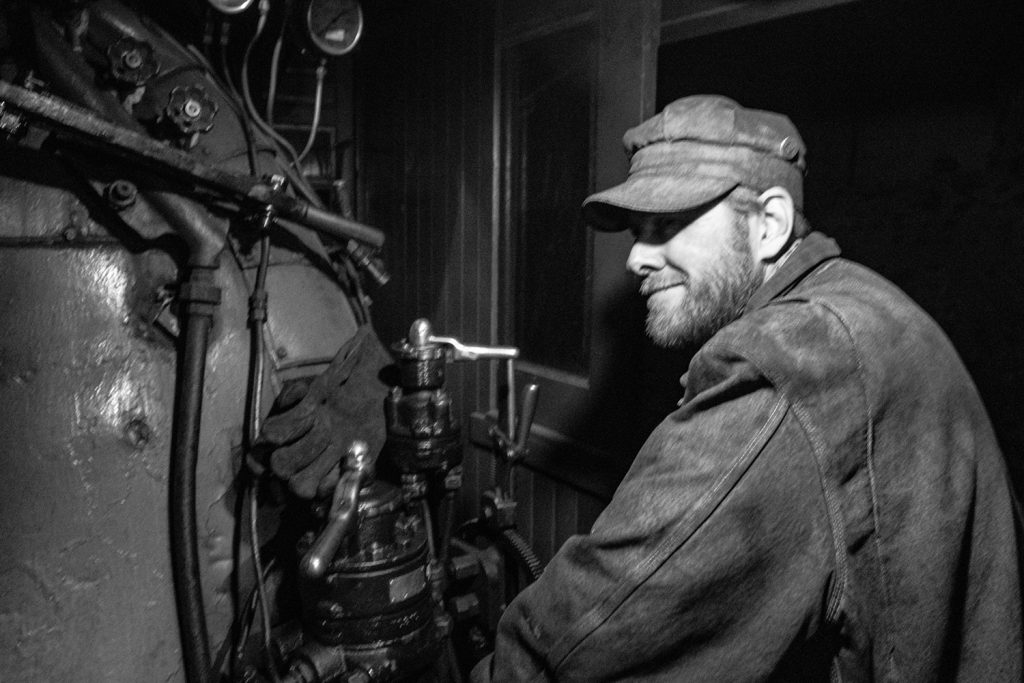
The night session was wrapping up by about 7:30 p.m., but I was invited up into the cab of the 93 to get a peek.
In the cab was engineer Bill Megill, who has been working with steam locomotives for 28 years now. This was my second time interacting with Megill, and I am always inspired by the passion that he has for steam railroading. I interviewed Megill a year ago and he told me that people like him do the work he does not because it’s a job, but because they love it. Railroading is hard, tiring and dirty, but his passion for it keeps him going to work.
I snapped this photo of him, illuminated only by the overhead light on the ceiling in the cab. The lighting wasn’t very attractive for an image in color, but I think it worked quite nicely for one in black & white.
Day 2
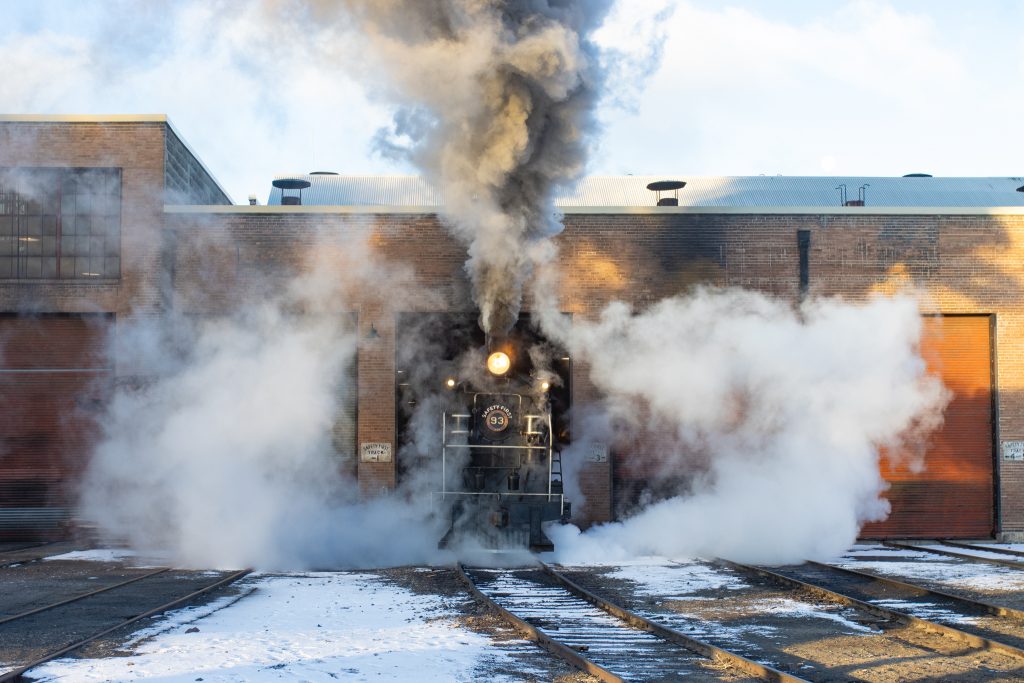
The next morning, several of us photographers arrived at the engine house at 6 a.m. to witness the train and shop crews preparing Locomotive 93 for its trip on the line later that morning. A lot of prep work goes into making sure the engine will perform as it should on the road. Many of the crew members had already arrived hours earlier.
At 7 a.m., the 93 exited the engine house with no shortage of smoke and steam. Part of the appeal of these winter photoshoots is that there is a lot of dramatic steam clouds because of the cold weather. The steam escaping from the engine essentially works the same way as when you are able to see your breath on a cold morning. During warmer weather, it’s much harder to get condensation like this.
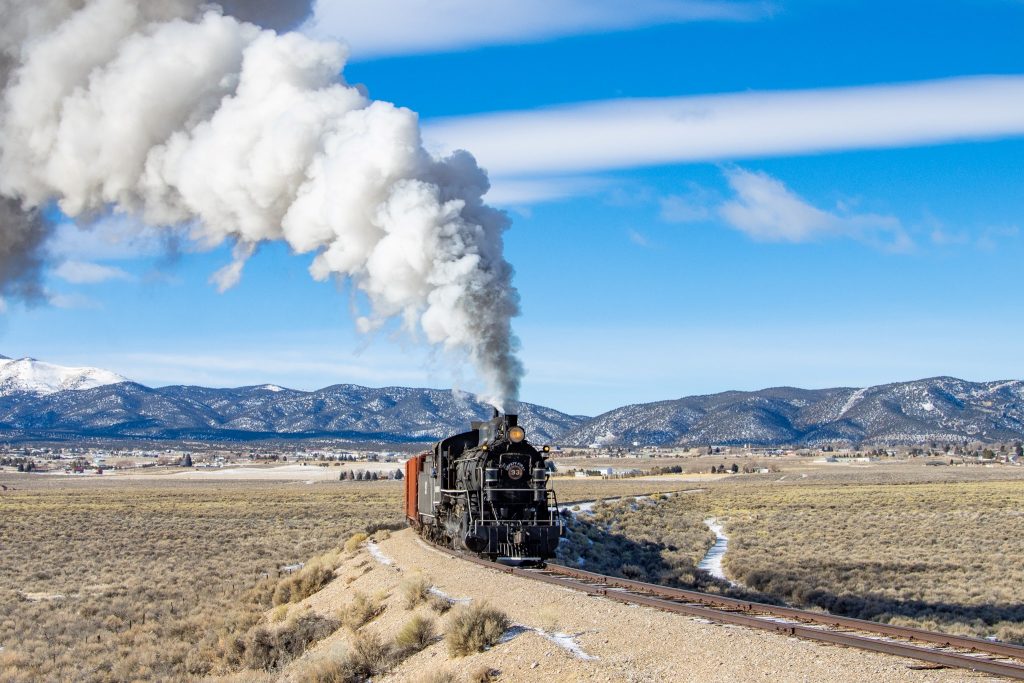
At 8:30 a.m., our train left the East Ely depot heading north on the mainline with a mixed train that had several freight cars that were as old as 113. The “mainline” was the longest line on the Nevada Northern’s system, and extended 114 miles north from Ely to the ghost town of Cobre where it connected with the larger national rail network. We rode in two passenger cars that were placed towards the rear of the train. The idea was to recreate a “mixed” train that would have been common here a century ago. A mixed train is a train made up of cars that transport both freight and passengers.
During our ride, the train would stop at several scenic locations along the route. We would deboard the train and set up in a “photo line”, and the train would back up a distance and run by our cameras. The photo here is taken at a fill. A fill is a man-made mound or deposit that is used to raise or level the ground (notice that the track is much higher than the surrounding land).
I really liked this photo because I thought the lines with the rails, the steam and the train itself made for an interesting composition. The snowy mountains in the background and clouds against a vibrant blue sky were nice additions as well.
After our trip with our mixed train, we returned to Ely for a lunch break.
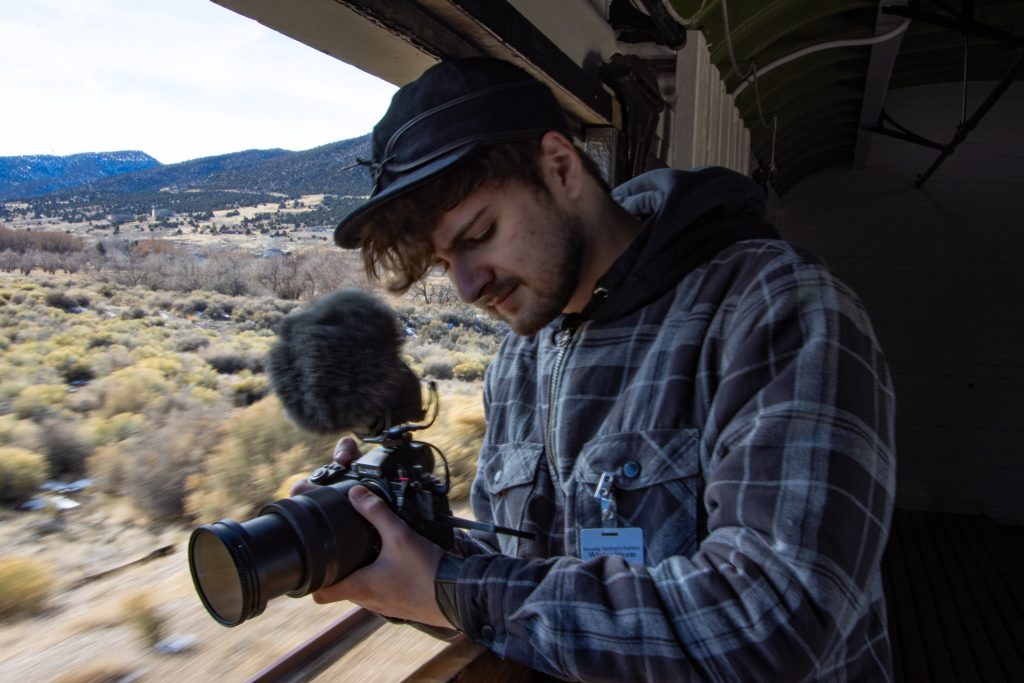
After lunch, we boarded a passenger train that was made up of a baggage/railway post office car and two coach cars. We were heading west towards the old mining town of Ruth, Nev. on a rail line called the Ore Line. The Ore Line was opened in 1908 and connected the copper mines around Ruth to the smelter located 12 miles northeast of Ely in the town of McGill.
On this weekend, I met a fellow scholarship contest winner who shares a first name in common with myself, Nick Martin. Studying film and media at Cleveland State University, Martin came all the way from Ohio to participate in the Winter Steam Photoshoot.
Martin’s focus is primarily in video, but he won the contest with some images he took on black & white film, which was unusual. He has a large following on social media thanks to his YouTube channel known as Pennsy Productions, where he produces video content on steam railroading.
Like myself, Martin has had a lifelong interest in railroading. He is part of a team of volunteers who are currently restoring their own steam locomotive back in Cleveland. Throughout the weekend, I was particularly interested in the video work that Martin was working on.
“I think growing up on platforms like YouTube, I was exposed to video work more than maybe generations before me who’ve been really more exposed to photos, so that’s what I’ve really gravitated towards,” Martin said.
The photo above depicts Martin filming from the open door of the baggage/railway post office car.
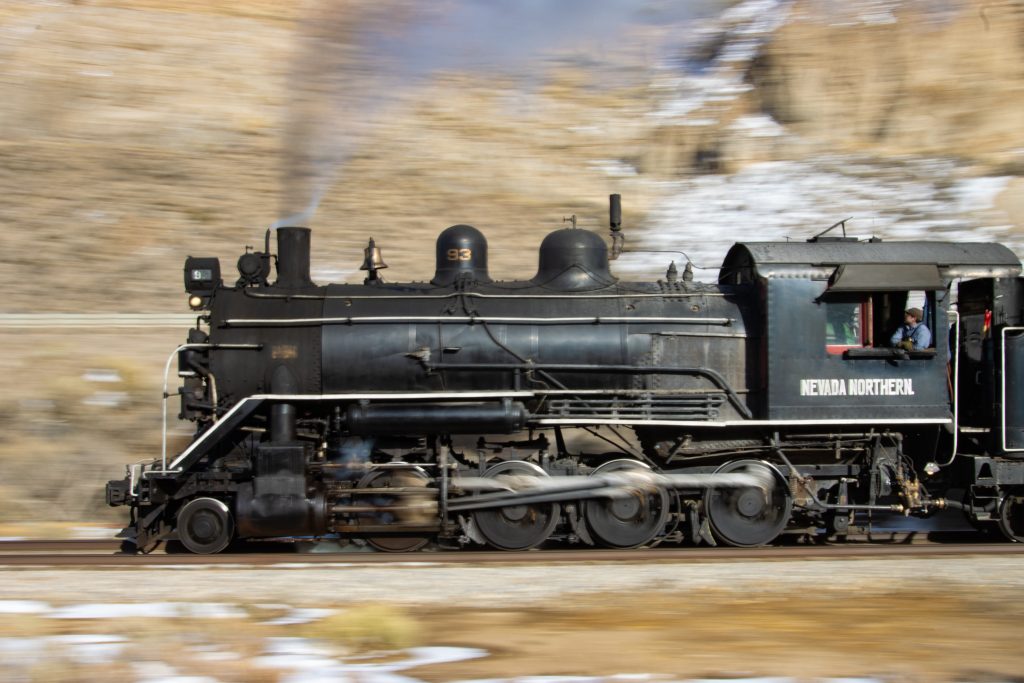
In Robinson Canyon, there was still some snow left from the previous day’s snowstorm. We stopped for another photo run-by along U.S. 50 outside of Ruth, where I set up on a hillside and got this photo of the 93 gaining speed. I set my ISO to 100, my aperture to f/22 and slowed my shutter speed to 1/15 to get this panning effect where the scenery gets some motion blur, but the train stays mostly sharp. This gives the train kind of a “speed” quality.
For each location we stop at, photographers would get roughly three run-bys in order for people to be able to try different ideas for photos.
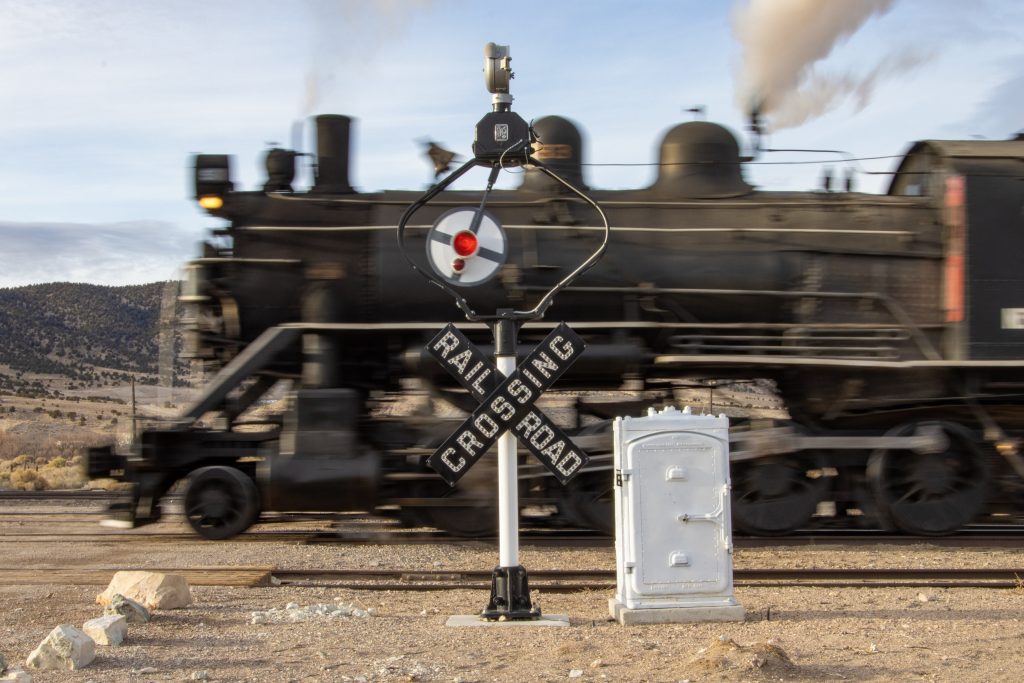
Now late in the afternoon, we returned to Ely and set up for one more run-by for the day.
We stopped a short distance from the East Ely depot to get photos with the historic “wig wag” signals. A “wig wag” is one of the earliest grade crossing devices designed to warn people and motorists of an oncoming train. They are original to this railroad and were restored a little over a decade ago.
Like the last photo, I was going for a “speed” effect here, but this time the train had motion blur on it while the surroundings were sharp. I used the same settings as I did for the last photo, but did not pan the camera and kept it still.
Day 3
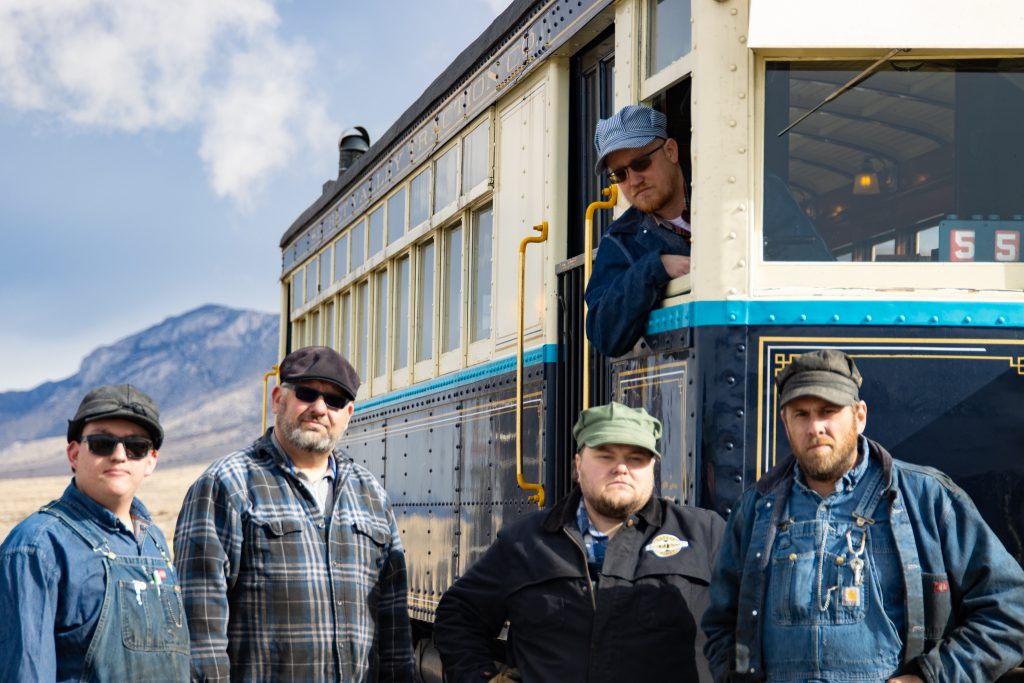
On our last day, the railroad dragged out their newest piece of equipment known as a “Doodlebug”. A “Doodlebug” looks similar to a trolley or streetcar you might see in an urban area. It is a self propelled passenger car that runs on a full-sized railroad. This one was built in 1930 and is powered by a Chevy V-8 engine.
The Doodlebug was delivered only less than a week before the Winter Steam Photoshoot. While not original to the railroad, the purpose of this car is to give rides to visitors on days with low ridership, and therefore increasing efficiency since they would not have to put together a full train for only a small handful of riders.
To conclude the event, us photographers were shuttled around in this car to our different photo locations rather than riding behind Locomotive 93. The Doodlebug left the East Ely depot heading north on the mainline at 8:30 a.m., and the 93 followed not far behind.
The Doodlebug dropped us off at our photo locations, and then moved out of the way so that we could get our photos with the 93.
During our stop at a location called “Hiline Junction”, crew members from both the Doodlebug and the 93 posed in front of the car for some photos.

After stopping for photo opportunities at ‘Hiline Junction’, everyone else was getting back on the Doodlebug to make our way back to Ely, but I was going somewhere else. I climbed up into the cab of Locomotive 93 to ride with the steam crew. I had an idea for some photos and asked the railroad trainmaster if that was something that could be arranged.
The cab was a lot warmer than outside. When the firebox doors would open, the heat was overwhelming.
Sitting diagonally from me in the cab was Max Harris. Harris was also a previous scholarship winner, but he later became an intern for the railroad and currently he is a volunteer. On this weekend, Harris was our fireman in the 93. A locomotive fireman is in charge of keeping the fire burning hot while also making sure there’s enough water in the boiler.
I found Harris to be interesting because he is only a couple years older than me, but he is working among a team that are mostly over 20 years older than he is. I asked him about why he thinks its important for someone of our age to be learning the kind of skills that he has.
“Outside of my general passion and appreciation for steam locomotives, I feel that learning and understanding the craft of working with these machines is an important homage to the past,” Harris said. “We can study history in books, but nothing shows what it actually took to fuel the past and build the future like learning and doing it the old fashioned way.”
For my photo of Harris, a silhouette made the most sense to me because the inside of the cab does not have very much light except from the windows. I really liked the way the silhouette contrasted against the scenery outside and it made for a good balance of dark and light.
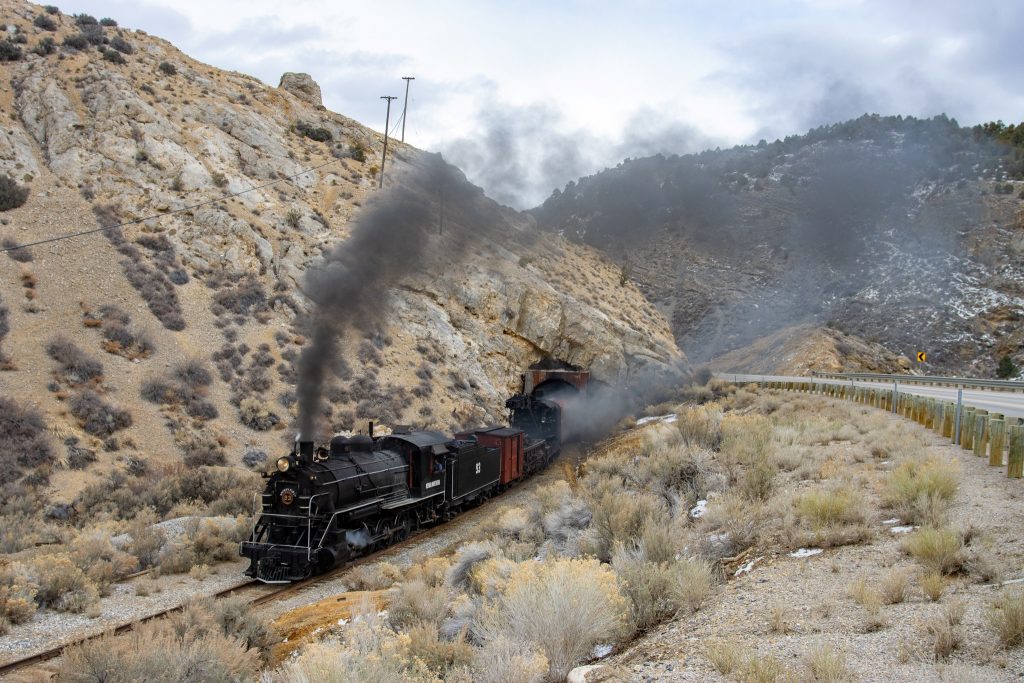
To wrap up our three day-long trip, the railroad put together a “wreck” train for the photographers.
A wreck train is a train that is equipped to clear the tracks of either debris or damaged equipment that may have derailed. Our train featured a steam-powered wreck crane which can still operate when necessary. There was no wreck on the line, but it was a staged recreation of what a wreck train would have looked like back in the day.
While I wasn’t totally thrilled with the lighting situation in this photo, there were some other qualities about it that I did like. To my eye, I almost see a spiral between the curving of the train, the highway on the right and curve of the rocks above the tunnel. I also like that the smoke is ‘peeling’ off the train as it is exiting the tunnel.
End Results
I was pretty thrilled with all of the content that I collected over the weekend. A lot of the scenes were staged for photographers since it was an event specifically for photographers after all, but I feel like some people were focused only on the trains themselves. For normal rail photographers, I think that’s perfectly acceptable since that is of course the main subject. I did a lot of that over the weekend too, but since I am trying to build on my photojournalism skills as someone who is studying it, I thought it was equally important to look at the “behind the scenes” of the event. That’s why I incorporated a lot of the natural human element, like with some of the environmental portraits of some of the people I interacted with over the weekend.
This event overall gave me the opportunity to look for new ideas and execute them, which will help me in the long run with my photography endeavors.
Nick Stewart can be reached via email ns@sagebrush.unr.edu or via X @nickk_stewart

